I am updating my battery system on the boat (1989 Catalina 30); I’ve included a crude diagram of it currently. I want to add an Isolator to the mix to keep my starting battery from draining accidentally and I want to add a Battery monitor. I am not sure where to wire each of these and how. I’ve read that if the alternator is jumpered to the starter, which I believe my M25XP is, then I need to disconnect that jumper and run the cable direct from the Alternator, but I don’t know.
I‘ve already bought a Renogy 500A Battery monitor that runs off a shunt and a FET 3 Bank Isolator. I just don’t know where to insert all of that, and I don’t know if I need to change the way my altenator and starter are wired.
Any help or advice would be great
I‘ve already bought a Renogy 500A Battery monitor that runs off a shunt and a FET 3 Bank Isolator. I just don’t know where to insert all of that, and I don’t know if I need to change the way my altenator and starter are wired.
Any help or advice would be great
Attachments
-
548.5 KB Views: 243





